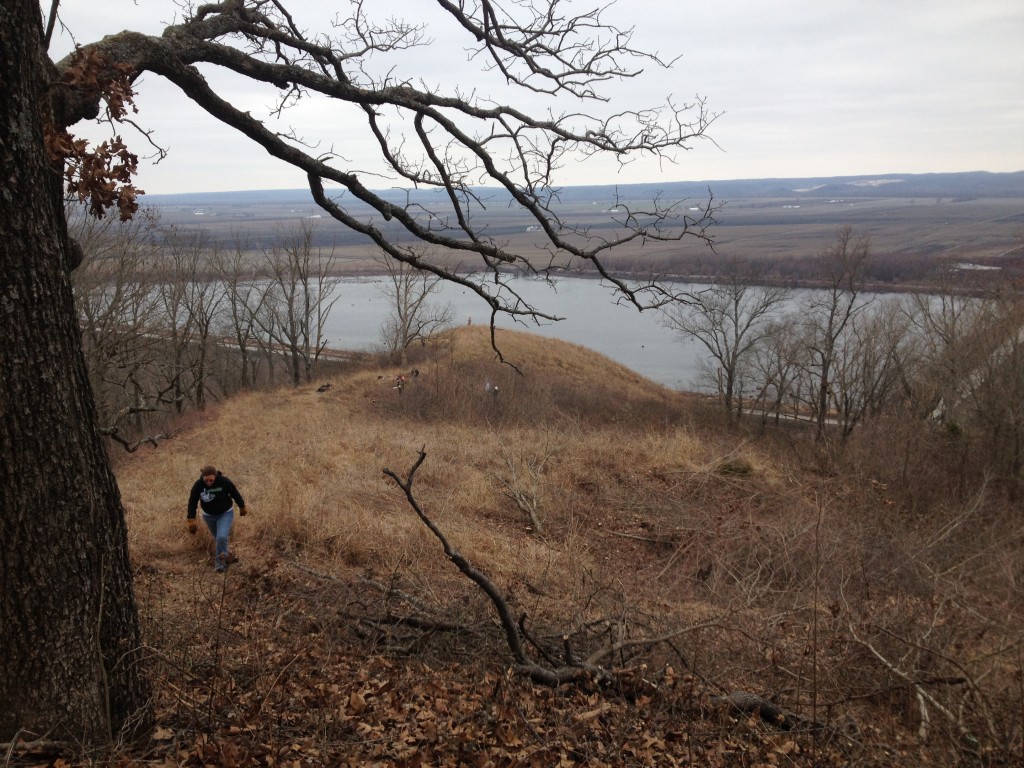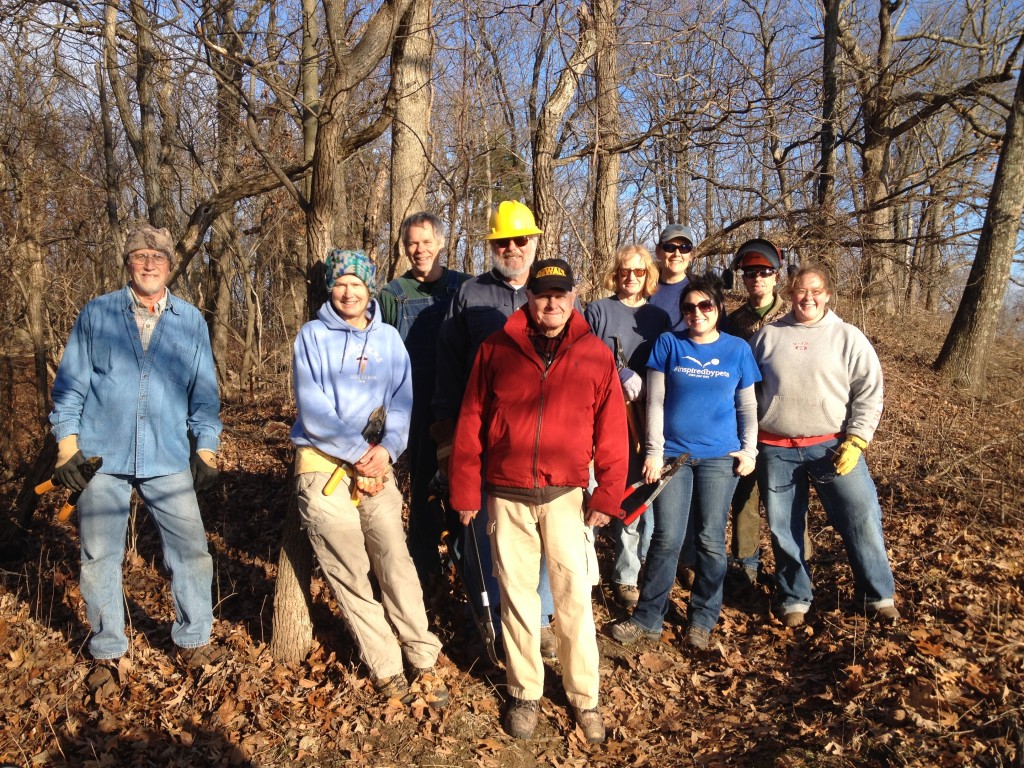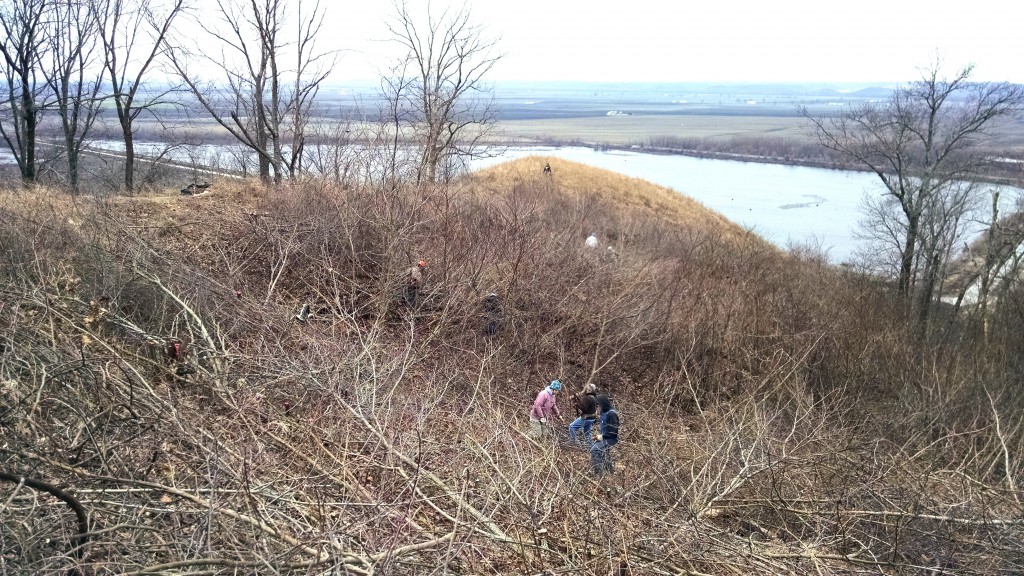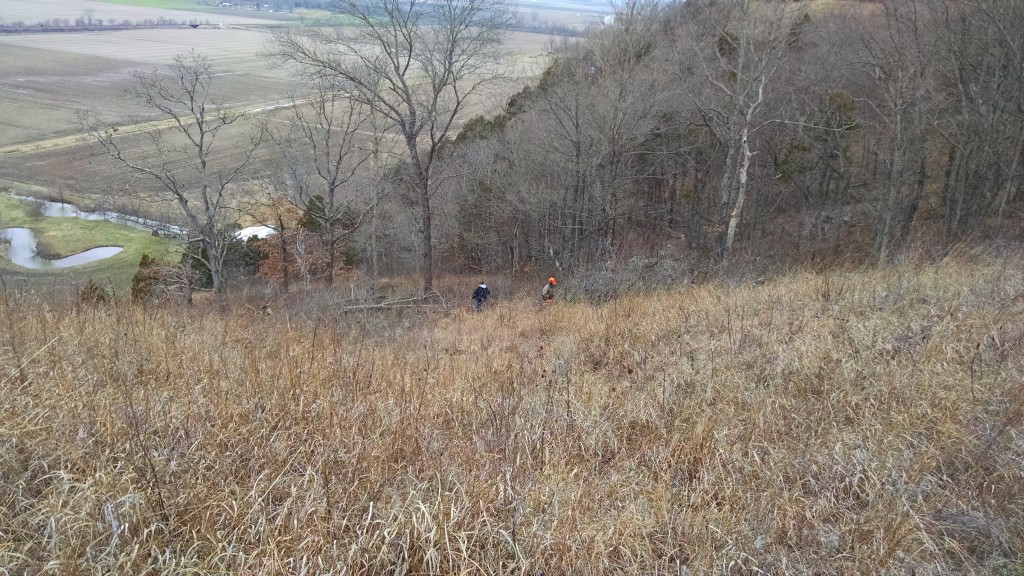SWAT for Improved Habitat at Fults Hill Prairie Nature Preserve

A long walk for stewardship at one of the hill prairies: a relatively easy hike, after the steep assent from the parking area up to the top of the bluffs. Photo courtesy Eric Smith, IDNR,
Many hands make light work…
So do many pairs of legs, strong arms and backs, chainsaws, brush cutters, herbicide applicators and, most assuredly, a cooperative effort to get a lot of work done.

CLIFFhanger volunteers joined with IDNR/INPC staff for three SWAT workdays on Fults Hill Prairie Nature Preserve. Photo courtesy Eric Smith, INDR.
In late January a team of people assembled from across the state for three days of heavy work to clear brush and woody plants that had invaded and were degrading the hill prairies of Fults Hill Prairie Nature Preserve. In three short days about 20 acres of the hill prairies were treated with the collective efforts of more than 240 people hours.
They call it a “SWAT,” a purposeful echo of the police acronym and 1980’s television drama “Special Weapons and Tactics” to denote the concept of a special force with special equipment. The Illinois Department of Natural Resources (IDNR) first used the concept back in the 1980s when Natural Heritage staff members decided to pool resources for needed work at targeted Nature Preserves, sites dedicated or registered with the Illinois Nature Preserves Commission (INPC). Sometimes the work involved large-scale heavy-labor stewardship tasks, but the benefits of group work also were brought to tasks as diverse conducting full biological inventories at a select site or even specific tasks such as a mussel survey on a particular stream.
Over the years, as funding for IDNR staff and stewardship has waxed and waned, SWAT events have changed in frequency. Right now, faced with funding difficulties and reduced staffing, but only too well aware of critical stewardship needs, IDNR is renewing use of the concept and the needed teamwork. In other areas of the state, single-day SWATs have been accomplished for critical work on Nature Preserve sites. The 13 IDNR/INPC folks and nearly a dozen Clifftop volunteers worked at two large prairies at Fults Hill Prairie Nature Preserve from the 24th through the 26th of January. IDNR staff members from Natural Heritage, Forestry, and Wildlife Divisions, an INPC staff member and interns with IDNR/INPC, came in from their normal assigned areas to work together. Clifftop volunteers, including a contingent led by a retired IDNR Forester, joined them. The prairies at Fults have declined due to heavy woody plant encroachment and the SWAT was designed to give this very special natural area some much-needed labor-intensive stewardship.
Recognizing the singular uniqueness of the hill prairies, the State of Illinois established Fults Hill Prairie Nature Preserve in 1970. Located just south of the Village of Fults along Bluff Road, the 532-acre site contains the largest complex of hill prairies in Illinois. In 1986, the U.S. Department of Interior’s National Park Service designated Fults Hill Prairie a National Natural Landmark. There are only 600 such landmarks in the entire country. Our bluff lands shelter a little known, one-of-a-kind natural national treasure, in our own backyard.
The bluff lands of Monroe County historically were completely forested, excepting on the cliff edges and in forest openings, called glades. Today, our bluff lands are home to more hill prairies than any other county in Illinois. Many of the hill prairies can be easily spotted from Bluff Road, clinging to the slopes, from the tree lines to the cliff edges. The hill prairies of Monroe County differ from others in the state because of a unique geologic history.
Pleistocene glaciers that covered most of Illinois and which were responsible for the pancake flatness of most of our state, didn’t quite reach the bluff lands and hill prairie corridor. Our landscape is really a geographic extension of Missouri’s Ozark Plateau jutting into Illinois. As a result, our hill prairies host some unusual plants and animals, more characteristic of Missouri and the West, and rare or nonexistent elsewhere in Illinois.
Hill prairies are distinctive natural communities occurring along the bluff tops of major rivers in the Midwest. They are island-like small patches of prairie growing on the steep south- and southwest-facing slopes immediately above the cliffs. The hot, windy and dry conditions on the slopes discourage all but the hardiest prairie plants. Hill prairies are a collage of plants — broad-leaved plants called forbs and grasses — growing close together, sharing and competing for resources. This arms race for resources — for sunlight, soil moisture and nutrients — results in the plants taking turns at growth and flowering. Small, short forbs grow and flower earlier racing ahead of the taller grasses to stay in the sunlight. By midsummer, three tall grasses dominate the hill prairies: thigh-high side-oats grama, waist-high little bluestem, and head-high Indian grass. Flowers are interspersed with the grasses, providing nectar for butterflies and other pollinators, and plenty of foodstuffs for insect herbivores.
The succession of flowering plants offers a consistent food larder for insects. For example, numerous species of milkweeds, each with a different blooming time, offer flowers and fresh leaves throughout the seasons for breeding and migratory Monarch butterflies.
But the rich diversity of life hill prairies bring forth is under threat. Researchers with the Morton Arboretum, Lisle, IL, note that hill prairies throughout our state have been reducing in area since the 1960s, with significant impact on biodiversity within these sites as shrubby woody vegetation flourishes and grasses and flowers fail under the resultant shade. Michael Jones and Marlin Bowles of the Arboretum note that earlier researchers documented significant loss of hill prairie area – approximately 10% per decade since the 1950s – based on analysis of aerial photos. Should that loss rate continue, statistical analysis shows that 80 to 100 percent of the prairie area at Fults Hill Prairie could be lost by 2040. Jones and Bowles analyzed Red Cedar trees to create a chronology of fire at Fults prairie sites and found that from the 1880s to the 1960s about five fires per decade occurred, with more frequent – and probably more heat-intense – fires during drought years. The researchers found no data on burns from 1970-1990, but burn data provided by IDNR show that since 1990, prescribed burns at the site have had a frequency of 1.2 fires per decade.
Jones and Bowles’ research highlights a direct correlation between reduction in fire frequency and intensity with the reduction and loss of hill prairie area. Management implications include more frequent prescribed fire and labor-intensive ongoing removal of invasive woody vegetation to help the prairie areas recover and, with continued management and stewardship, even expand towards their historic area of coverage.

The SWAT members provided much-needed brush cutting on about 20 acres of hill prairie lands with an estimated 240 cumulative hours of work over three January days. Photo courtesy Michelle Simone, IDNR..
The three days and cumulative 240+ hours of intensive care given at Fults Hill Prairie Nature Preserve by IDNR personnel and CLIFFhanger volunteers helped reduce the woody vegetation and will allow these prairies – and all the biodiversity that depends on these islands of grass – to continue and flourish for another season of growth. We hope to reassemble again this year, to join hands and again make light the hard labor of stewardship and ring the prairies with the renewing, regenerating power of fire.
CLIFFTOP, a local nonprofit organization, is focused on preserving and protecting area bluff lands.
A version of this article appeared in the 17 February 2017 edition of the Monroe County Independent.
© 2017 all content rights reserved Clifftop NFP
Comments are currently closed.

